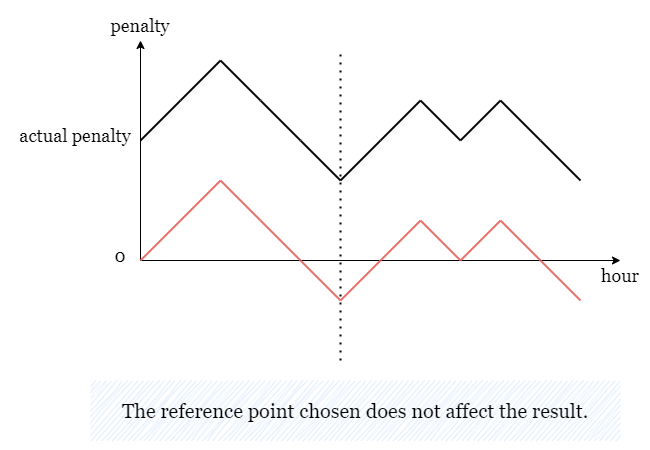Problem
You are given the customer visit log of a shop represented by a
zero-indexed string customers consisting only of characters N and
Y. If the \(i^{th}\) character is Y, it means that customers come
at the \(i^{th}\) hour, whereas N indicates that no customers come
at the \(i^{th}\) hour.
If the shop closes at the \(j^{th}\) hour (\(0 \le j \le n\)), the penalty is calculated as follows:
- For every hour when the shop is open and no customers come, the penalty increases by \(1\).
- For every hour when the shop is closed and customers come, the penalty increases by \(1\).
Return the earliest hour at which the shop must be closed to incur a minimum penalty. Note that if the shop closes at the \(j^{th}\) hour, it means the shop is closed at the hour \(j\).
Solution
Consider the string YYNY. There are two parts to the penalty at each
hour:
| Hour | Pre-Close Penalty | Post-Close Penalty | Penalty |
|---|---|---|---|
| 0 | 0 | 3 YYNY | 3 |
| 1 | 0 Y | 2 YNY | 2 |
| 2 | 0 YY | 1 NY | 1 |
| 3 | 1 YYN | 1 Y | 2 |
| 4 | 1 YYNY | 0 | 1 |
The pre-close and post-close penalties are both monotonic. At each step, there is a penalty of \(1\) that either goes to either increasing the pre-close penalty or decreasing the post-close penalty.
Implementation
def best_closing_time(customers: str) -> int:
# Set the initial values.
suffix_penalty = sum(1 if c == 'Y' else 0 for c in customers)
prefix_penalty = 0
best_hour = 0
min_penalty = suffix_penalty + prefix_penalty
# Review the rest of the string and update the best value found.
for hour in range(1, len(customers) + 1):
if customers[hour-1] == 'Y':
suffix_penalty -= 1
else:
prefix_penalty += 1
penalty = prefix_penalty + suffix_penalty
if penalty < min_penalty:
best_hour = hour
min_penalty = penalty
return best_hour
Runtime \(\mathcal{O}(N)\). Space usage: \(\mathcal{O}(1)\).
I’ve seen this pattern before in Minimizing Bottom-Right Paths in a 2xN Grid , where we have a initial value that we update on seeing the next item in the collection.
Learnings
tags this problem with “Prefix Sum”, a class of problems that feature the pattern \(y_i = y_{i-1} + x_i\). #prefix-sum
We do not need to separately maintain prefix_penalty and
suffix_penalty.
Implementation with single penalty value
def best_closing_time(customers: str) -> int:
# Set the initial values. Assume that we are closed at hour 0.
penalty = sum(1 if c == 'Y' else 0 for c in customers)
earliest_closing_hour = 0
min_penalty = penalty
# Try closing the shop at hours 1, ..., n-1
for latest_open_hour, c in enumerate(customers):
# If there is a customer at this hour, moving it to open hours
# decreases the penalty by one. If there's no customer, then we
# incur a penalty by having the shop open.
penalty += -1 if c == 'Y' else 1
if penalty < min_penalty:
earliest_closing_hour = latest_open_hour + 1
penalty = min_penalty
return earliest_closing_hour
In the rewrite, using for latest_open_hour, c in enumerate(customer)
instead of for hour in range(1, len(customers) + 1) clarified my
thinking a lot. Another point for selecting good variable names and
using idiomatic constructs.
The initial pass over customers gets us the starting penalty. However,
the question asks for the earliest hour with the lowest penalty, and so
it’s the penalty of the hours relative to each other that matters, not
the specific penalty value.

The reference shifts the graph up or down. However, the shape of the graph does not change. Source: leetCode2483Editorial
Implementation in a single pass
def best_closing_time(customers: str) -> int:
# Assume that we are closed at hour 0. Set zero as the reference
# point.
penalty = 0
earliest_closing_hour = 0
min_penalty = penalty
for latest_open_hour, c in enumerate(customers):
# If there is a customer at this hour, moving it to open hours
# decreases the penalty by one. If there's no customer, then we
# incur a penalty by having the shop open.
penalty += -1 if c == 'Y' else 1
if penalty < min_penalty:
earliest_closing_hour = latest_open_hour + 1
min_penalty = penalty
return earliest_closing_hour
References
- Prefix sum - Wikipedia. en.wikipedia.org . Accessed Jul 21, 2024.
- Minimum Penalty for a Shop > Editorial. leetcode.com . Accessed Jul 21, 2024.
From a pure refactor perspective, could I have been able to infer this?
min_penaltyis triviallysuffix_penaltybecauseprefix_penaltyis \(0\).In the
Ycase,penalty = prefix_penalty + suffix_penalty - 1, while in theNcase,penalty = prefix_penalty + 1 + suffix_penalty. Therefore,prefix_penalty + suffix_penaltycan be collapsed into one value.